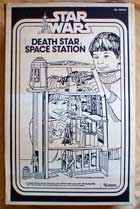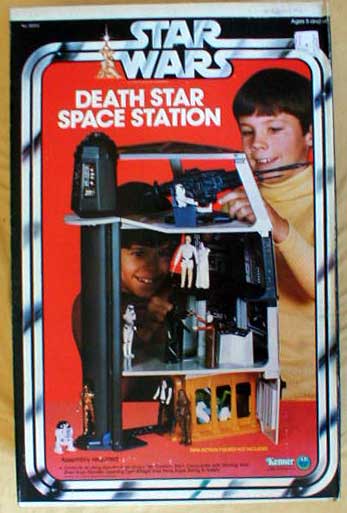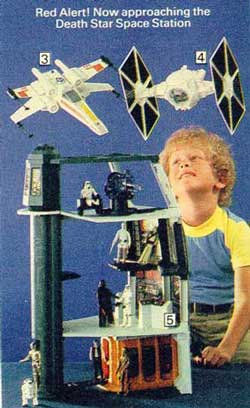
Box Back (click to enlarge)

| Catalog Entry | |
 |
Catalog Description:
HOW IT WORKS. Manual elevator takes figures to any of four floors. Top floor features laser cannon which emits clicking sound as it swivels into action. Push button explodes cannon from housing simulating a "hit." Third floor has manual light bridge which opens and closes. Second floor features control console and escape hatch to garbage compactor with simulated garbage and reptile monster found on first floor. For children ages 5 years and up. Source: 1978 Sears Wish Book |
Description:
The first and greatest of Kenner's Star Wars playsets, the Death Star Space Station was any kid's dream. It was a full 20 inches tall, with four floors on which one could recreate a whole range of exciting Star Wars scenes. It had a really cool looking gun mount on its top level, a retractable bridge in its middle portion, even a working trash compactor component, which, of course, was located in its inner depths. But best of all was the Dianoga, a creature so great that multiple mini-series should be filmed about its life dwelling within the murky depths of the trash compactor. In the film, kids only got to see its single beady eye, peeking up out of the trash at Luke and his counterparts. But Kenner took us one step further. Once you saw their toy version of the thing, you realized that not only did it possess a single eye extending upwards on a periscope-like neck, it had a freakin' mouth in its chest. Cool, huh? Well, ok, the thing was ridiculous. But ridiculous is cool.
The Death Star has always been popular with collectors. However, piecing together a loose example can be quite a challenge, as several of its parts are small and easily lost. The plastic "rope," which hung over the gap spanned by the bridge, is particularly hard to locate. The set also came with blocks of foam, which kids were supposed to cut up into mock "trash" for the compactor, as well as two flimsy cardboard inserts, intended to represent either the inner walls of the space station or its detailed exterior, depending on which of their sides you looked at.
In unused, packaged condition, the toy is downright rare, and the values of examples in this state can extend into the area of four figures. Although the Death Star was a popular toy in 1978 and '79, it unfortunately was not issued as part of the later ESB line. However, a slight packaging variation does exist: whereas the '78 issue features the "LP" logo (short for "Long Play") on its front, the '79 issue does not.
Due to the expensive nature of its manufacture, most countries chose not to sell this large plastic Death Star toy. Instead, many, including France, Australia and Great Britian, issued a nifty, graphically-intense version of the space station that was constructed of heavy chipboard. Unfortunatately, this toy never saw the light of day in the States. Canada, however, was lucky enough to see the release of both cardboard and plastic Death Stars, it being the only country aside from the U.S.A. in which the latter toy was released.
First Issued: 1978 (SW packaging, with "LP" logo)
Re-issues: 1979 (SW packaging, without "LP" logo)